19 physics question
Question Description
1-Global warming is a cause for concern because even small changes in the Earth's temperature can have significant consequences. For example, if the Earth's polar ice caps were to melt entirely, the resulting additional water in the oceans would flood many coastal areas. Model the polar ice as having a combined mass of  1019
1019 105
105
s
%
2-(a) Calculate the absolute pressure at the bottom of a freshwater lake at a point whose depth is 25.8 m. Assume the density of the water is  103
103
Pa
(b) What force is exerted by the water on the window of an underwater vehicle at this depth if the window is circular and has a diameter of 34.4 cm?
N
3-A solid sphere of brass (bulk modulus of  1011
1011
4-The figure below shows a stream of water in a steady flow from a kitchen faucet. At the faucet the diameter of the stream is 1.10 cm. The stream fills a 125 cm3 container in 14.4 s. Find the diameter of the stream 13.0 cm below the opening of the faucet.
cm5-The Venturi tube shown in the figure below may be used as a fluid flowmeter. Suppose the device is used at a service station to measure the flow rate of gasoline (ρ =  102
102
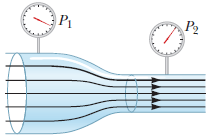
(a) Find the speed of the gasoline as it leaves the hose.
m/s
(b) Find the fluid flow rate in cubic meters per second.
m3/s
6-The Bernoulli effect can have important consequences for the design of buildings. For example, wind can blow around a skyscraper at remarkably high speed, creating low pressure. The higher atmospheric pressure in the still air inside the buildings can cause windows to pop out. As originally constructed, the John Hancock building in Boston popped window panes, which fell many stories to the sidewalk below.
(a) Suppose that a horizontal wind blows in streamline flow with a speed of 10.9 m/s outside a large pane of plate glass with dimensions 5.00 m ✕ 1.60 m. Assume the density of air to be constant at 1.20 kg/m3. The air inside the building is at atmospheric pressure. What is the total force exerted by air on the window pane?
N outward
(b) If a second skyscraper is built nearby, the air speed can be especially high where wind passes through the narrow separation between the buildings. Solve part (a) again if the wind speed is 21.8 m/s, twice as high.
kN outward
7-(a) Calculate the absolute pressure at an ocean depth of 50 m. Assume the density of sea water is
(b) At this depth, what is the buoyant force on a spherical submarine having a diameter of 5.10 m?
N
8-The kinetic energy of an object is increased by a factor of 2.5, by what factor is the magnitude of its momentum changed?
times
9-A

(a) What is the velocity of the truck right after the collision? (Give your answer to five significant figures.) m/s east
m/s east
10-A rod of length 40.00 cm has linear density (mass per length) given by
λ = 50.0 + 17.0x
where x is the distance from one end, and λ is measured in grams/meter.
(a) What is its mass?
g
(b) How far from the x = 0 end is its center of mass?
11-A 2.03-kg particle has a velocity (1.99 î − 3.01 ĵ) m/s, and a 3.08-kg particle has a velocity (0.93 î + 6.03 ĵ) m/s.
(a) Find the velocity of the center of mass.
 |
How is the velocity of the center of mass related to the total momentum of the system? î +
 |
(b) Find the total momentum of the system.
 |
12-A 70.0 kg person bends his knees and then jumps straight up. After his feet leave the floor, his motion is unaffected by air resistance and his center of mass rises by a maximum of 15.1 cm. Model the floor as completely solid and motionless.
(a) With what momentum does the person leave the floor?
(b) With what kinetic energy does the person leave the floor?
J
13-A model rocket engine has an average thrust of 5.26 N. It has an initial mass of 25.6 g, which includes fuel mass of 13.0 g. The duration of its burn is 1.90 s. (Assume all the fuel is consumed.)
(a) What is the average exhaust speed of the engine?
m/s
(b) This engine is placed in a rocket body of mass 44.5 g. What is the magnitude of the final velocity of the rocket if it were to be fired from rest in outer space by an astronaut on a spacewalk? Assume the fuel burns at a constant rate.
14-A 3.30-kg steel ball strikes a wall with a speed of 9.0 m/s at an angle of θ = 60.0° with the surface. It bounces off with the same speed and angle (see figure below). If the ball is in contact with the wall for 0.200 s, what is the average force exerted by the wall on the ball? (Assume right and up are the positive directions.)
| Fx = | N |
15-A 0.440-kg blue bead slides on a frictionless, curved wire, starting from rest at point  in the figure below, where h = 1.50 m. At point
in the figure below, where h = 1.50 m. At point  , the blue bead collides elastically with a 0.550-kg green bead at rest. Find the maximum height the green bead rises as it moves up the wire.
, the blue bead collides elastically with a 0.550-kg green bead at rest. Find the maximum height the green bead rises as it moves up the wire.
m
16-A 5.00-g bullet moving with an initial speed of vi = 460 m/s is fired into and passes through a 1.00-kg block as shown in the figure below. The block, initially at rest on a frictionless, horizontal surface, is connected to a spring with force constant 910 N/m. The block moves d = 5.20 cm to the right after impact before being brought to rest by the spring.
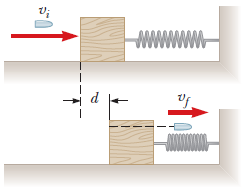
(a) Find the speed at which the bullet emerges from the block.
m/s
(b) Find the amount of initial kinetic energy of the bullet that is converted into internal energy in bullet–block system during the collision.
J
17-Example 13.2 Variation of g with Altitude h
The International Space Station operates at an altitude of 350 km. Plans for the final construction show that  106
106
SOLVE IT
Conceptualize The mass of the space station is fixed; it is independent of its location. Based on the discussion in this section, we realize that the value of g will be reduced at the height of the space station's orbit. Therefore, its weight will be smaller than that at the surface of the Earth.
Categorize This example is a relatively simple substitution problem.
Find the mass of the space station from its weight at the surface of the Earth:
| m = |
| = |
| =  105 105 |
Use the equation for the free-fall acceleration with h = 350 km to find g at the orbital location:
| g = |
|
| = |
| = 8.83 m / s2 |
Use this value of g to find the space station's weight in orbit:
mg = ( 105
105![]() N
N
At what altitude is the space station's weight 50% of its value on Earth's surface?
h =
18-This question has several parts that must be completed sequentially. If you skip a part of the question, you will not receive any points for the skipped part, and you will not be able to come back to the skipped part.
Tutorial Exercise
In the system shown in the figure below, a horizontal force  x acts on an object of mass m2 = 7.05 kg. The horizontal surface is frictionless. Consider the acceleration of the sliding object as a function of Fx.
x acts on an object of mass m2 = 7.05 kg. The horizontal surface is frictionless. Consider the acceleration of the sliding object as a function of Fx.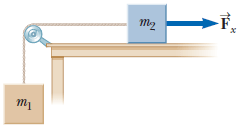
(a) For what values of Fx does the object of mass m1 = 3.75 kg accelerate upward?
(b) For what values of Fx is the tension in the cord zero?
(c) Plot the acceleration of the m2 object versus Fx. Include values of Fx from −100 N to +100 N.
Part 1 of 4 - Conceptualize
The applied horizontal force can be either positive (to the right) or negative (to the left). As the force increases through sufficiently large positive values, acceleration to the right increases linearly. When Fx is negative, the acceleration is negative, and at some point the cord will go slack. At small positive values of the force, the larger mass is counterbalancing some of the weight of the smaller mass.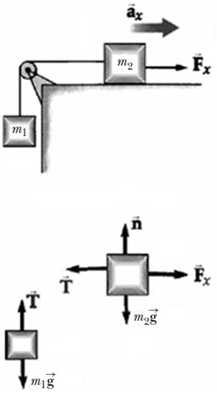
Part 2 of 4 - Categorize
We use the particle under a net force model for each of the two objects separately. Then we combine the equations to solve for acceleration of the blocks and the tension in the cord.
Part 3 of 4 - Analyze
Let  be the tension in the connecting cord, with magnitude |
be the tension in the connecting cord, with magnitude | | = T.
| = T.
The forces acting on the m1 = 3.75 kg block are given in the following equation. For this block, we subtract the force due to gravity from the tension in the cord.T − m1g = m1a
Fx − T = m2a
Since the force along the cord acts only in the x direction, we subtract the tension in the cord from the magnitude of this force. The downward force exerted on the table by the sliding block is −m2 . By Newton's third law, its equal but opposite force is
. By Newton's third law, its equal but opposite force is  , the normal force, and these forces cancel out. The sliding block remains on the flat surface, moving only in the xdirection.
, the normal force, and these forces cancel out. The sliding block remains on the flat surface, moving only in the xdirection.
(a) We eliminate T from these equations and solve for a.
a =
| Fx − m1g |
| m1 + m2 |
a > 0 for Fx > m1g = (No Response) 
36.8
N(b) We use the following equations again, but this time we eliminate a and solve for T.| T − m1g | = | m1a |
| Fx − T | = | m2a |
T =
| m1 |
| m1 + m2 |
 |
 |
T = 0 for Fx ≤ −m2g = (No Response) 
-69.1
NPart 4 of 4 - Analyze
(c) Now we will plot the acceleration of the m2 object versus Fx by filling in the values for a in the table below.
| Fx, N | -100 | -m2g = | -50.0 | 0 | 50.0 | 100 |
| a, m/s2 | Your response is within 10% of the correct value. This may be due to roundoff error, or you could have a mistake in your calculation. Carry out all intermediate results to at least four-digit accuracy to minimize roundoff error. | Your response differs from the correct answer by more than 10%. Double check your calculations. |
Look at the graph below (not to scale). Note that if Fx < −m2g, the cord is loose, so mass m1 is in free fall and mass m2 accelerates under the action of Fx only.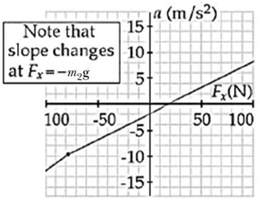 1-Global warming is a cause for concern because even small changes in the Earth's temperature can have significant consequences. For example, if the Earth's polar ice caps were to melt entirely, the resulting additional water in the oceans would flood many coastal areas. Model the polar ice as having a combined mass of
1-Global warming is a cause for concern because even small changes in the Earth's temperature can have significant consequences. For example, if the Earth's polar ice caps were to melt entirely, the resulting additional water in the oceans would flood many coastal areas. Model the polar ice as having a combined mass of  1019
1019 105
105
s
%
2-(a) Calculate the absolute pressure at the bottom of a freshwater lake at a point whose depth is 25.8 m. Assume the density of the water is  103
103
Pa
(b) What force is exerted by the water on the window of an underwater vehicle at this depth if the window is circular and has a diameter of 34.4 cm?
N
3-A solid sphere of brass (bulk modulus of  1011
1011
4-The figure below shows a stream of water in a steady flow from a kitchen faucet. At the faucet the diameter of the stream is 1.10 cm. The stream fills a 125 cm3 container in 14.4 s. Find the diameter of the stream 13.0 cm below the opening of the faucet.
cm5-The Venturi tube shown in the figure below may be used as a fluid flowmeter. Suppose the device is used at a service station to measure the flow rate of gasoline (ρ =  102
102

(a) Find the speed of the gasoline as it leaves the hose.
m/s
(b) Find the fluid flow rate in cubic meters per second.
m3/s
6-The Bernoulli effect can have important consequences for the design of buildings. For example, wind can blow around a skyscraper at remarkably high speed, creating low pressure. The higher atmospheric pressure in the still air inside the buildings can cause windows to pop out. As originally constructed, the John Hancock building in Boston popped window panes, which fell many stories to the sidewalk below.
(a) Suppose that a horizontal wind blows in streamline flow with a speed of 10.9 m/s outside a large pane of plate glass with dimensions 5.00 m ✕ 1.60 m. Assume the density of air to be constant at 1.20 kg/m3. The air inside the building is at atmospheric pressure. What is the total force exerted by air on the window pane?
N outward
(b) If a second skyscraper is built nearby, the air speed can be especially high where wind passes through the narrow separation between the buildings. Solve part (a) again if the wind speed is 21.8 m/s, twice as high.
kN outward
7-(a) Calculate the absolute pressure at an ocean depth of 50 m. Assume the density of sea water is
(b) At this depth, what is the buoyant force on a spherical submarine having a diameter of 5.10 m?
N
8-The kinetic energy of an object is increased by a factor of 2.5, by what factor is the magnitude of its momentum changed?
times
9-A

(a) What is the velocity of the truck right after the collision? (Give your answer to five significant figures.) m/s east
m/s east
10-A rod of length 40.00 cm has linear density (mass per length) given by
λ = 50.0 + 17.0x
where x is the distance from one end, and λ is measured in grams/meter.
(a) What is its mass?
g
(b) How far from the x = 0 end is its center of mass?
11-A 2.03-kg particle has a velocity (1.99 î − 3.01 ĵ) m/s, and a 3.08-kg particle has a velocity (0.93 î + 6.03 ĵ) m/s.
(a) Find the velocity of the center of mass.
 |
How is the velocity of the center of mass related to the total momentum of the system? î +
 |
(b) Find the total momentum of the system.
 |
12-A 70.0 kg person bends his knees and then jumps straight up. After his feet leave the floor, his motion is unaffected by air resistance and his center of mass rises by a maximum of 15.1 cm. Model the floor as completely solid and motionless.
(a) With what momentum does the person leave the floor?
(b) With what kinetic energy does the person leave the floor?
J
13-A model rocket engine has an average thrust of 5.26 N. It has an initial mass of 25.6 g, which includes fuel mass of 13.0 g. The duration of its burn is 1.90 s. (Assume all the fuel is consumed.)
(a) What is the average exhaust speed of the engine?
m/s
(b) This engine is placed in a rocket body of mass 44.5 g. What is the magnitude of the final velocity of the rocket if it were to be fired from rest in outer space by an astronaut on a spacewalk? Assume the fuel burns at a constant rate.
14-A 3.30-kg steel ball strikes a wall with a speed of 9.0 m/s at an angle of θ = 60.0° with the surface. It bounces off with the same speed and angle (see figure below). If the ball is in contact with the wall for 0.200 s, what is the average force exerted by the wall on the ball? (Assume right and up are the positive directions.)
| Fx = | N |
15-A 0.440-kg blue bead slides on a frictionless, curved wire, starting from rest at point  in the figure below, where h = 1.50 m. At point
in the figure below, where h = 1.50 m. At point  , the blue bead collides elastically with a 0.550-kg green bead at rest. Find the maximum height the green bead rises as it moves up the wire.
, the blue bead collides elastically with a 0.550-kg green bead at rest. Find the maximum height the green bead rises as it moves up the wire.
m
16-A 5.00-g bullet moving with an initial speed of vi = 460 m/s is fired into and passes through a 1.00-kg block as shown in the figure below. The block, initially at rest on a frictionless, horizontal surface, is connected to a spring with force constant 910 N/m. The block moves d = 5.20 cm to the right after impact before being brought to rest by the spring.

(a) Find the speed at which the bullet emerges from the block.
m/s
(b) Find the amount of initial kinetic energy of the bullet that is converted into internal energy in bullet–block system during the collision.
J
17-Example 13.2 Variation of g with Altitude h
The International Space Station operates at an altitude of 350 km. Plans for the final construction show that  106
106
SOLVE IT
Conceptualize The mass of the space station is fixed; it is independent of its location. Based on the discussion in this section, we realize that the value of g will be reduced at the height of the space station's orbit. Therefore, its weight will be smaller than that at the surface of the Earth.
Categorize This example is a relatively simple substitution problem.
Find the mass of the space station from its weight at the surface of the Earth:
| m = |
| = |
| =  105 105 |
Use the equation for the free-fall acceleration with h = 350 km to find g at the orbital location:
| g = |
|
| = |
| = 8.83 m / s2 |
Use this value of g to find the space station's weight in orbit:
mg = ( 105
105![]() N
N
At what altitude is the space station's weight 50% of its value on Earth's surface?
h =
18-This question has several parts that must be completed sequentially. If you skip a part of the question, you will not receive any points for the skipped part, and you will not be able to come back to the skipped part.
Tutorial Exercise
In the system shown in the figure below, a horizontal force  x acts on an object of mass m2 = 7.05 kg. The horizontal surface is frictionless. Consider the acceleration of the sliding object as a function of Fx.
x acts on an object of mass m2 = 7.05 kg. The horizontal surface is frictionless. Consider the acceleration of the sliding object as a function of Fx.
(a) For what values of Fx does the object of mass m1 = 3.75 kg accelerate upward?
(b) For what values of Fx is the tension in the cord zero?
(c) Plot the acceleration of the m2 object versus Fx. Include values of Fx from −100 N to +100 N.
Part 1 of 4 - Conceptualize
The applied horizontal force can be either positive (to the right) or negative (to the left). As the force increases through sufficiently large positive values, acceleration to the right increases linearly. When Fx is negative, the acceleration is negative, and at some point the cord will go slack. At small positive values of the force, the larger mass is counterbalancing some of the weight of the smaller mass.
Part 2 of 4 - Categorize
We use the particle under a net force model for each of the two objects separately. Then we combine the equations to solve for acceleration of the blocks and the tension in the cord.
Part 3 of 4 - Analyze
Let  be the tension in the connecting cord, with magnitude |
be the tension in the connecting cord, with magnitude | | = T.
| = T.
The forces acting on the m1 = 3.75 kg block are given in the following equation. For this block, we subtract the force due to gravity from the tension in the cord.T − m1g = m1a
Fx − T = m2a
Since the force along the cord acts only in the x direction, we subtract the tension in the cord from the magnitude of this force. The downward force exerted on the table by the sliding block is −m2 . By Newton's third law, its equal but opposite force is
. By Newton's third law, its equal but opposite force is  , the normal force, and these forces cancel out. The sliding block remains on the flat surface, moving only in the xdirection.
, the normal force, and these forces cancel out. The sliding block remains on the flat surface, moving only in the xdirection.
(a) We eliminate T from these equations and solve for a.
a =
| Fx − m1g |
| m1 + m2 |
a > 0 for Fx > m1g = (No Response) 
36.8
N(b) We use the following equations again, but this time we eliminate a and solve for T.| T − m1g | = | m1a |
| Fx − T | = | m2a |
T =
| m1 |
| m1 + m2 |
 |
 |
T = 0 for Fx ≤ −m2g = (No Response) 
-69.1
NPart 4 of 4 - Analyze
(c) Now we will plot the acceleration of the m2 object versus Fx by filling in the values for a in the table below.
| Fx, N | -100 | -m2g = | -50.0 | 0 | 50.0 | 100 |
| a, m/s2 | Your response is within 10% of the correct value. This may be due to roundoff error, or you could have a mistake in your calculation. Carry out all intermediate results to at least four-digit accuracy to minimize roundoff error. | Your response differs from the correct answer by more than 10%. Double check your calculations. |
Look at the graph below (not to scale). Note that if Fx < −m2g, the cord is loose, so mass m1 is in free fall and mass m2 accelerates under the action of Fx only.

This question has not been answered.
Create a free account to get help with this and any other question!
Brown University
1271 Tutors
California Institute of Technology
2131 Tutors
Carnegie Mellon University
982 Tutors
Columbia University
1256 Tutors
Dartmouth University
2113 Tutors
Emory University
2279 Tutors
Harvard University
599 Tutors
Massachusetts Institute of Technology
2319 Tutors
New York University
1645 Tutors
Notre Dam University
1911 Tutors
Oklahoma University
2122 Tutors
Pennsylvania State University
932 Tutors
Princeton University
1211 Tutors
Stanford University
983 Tutors
University of California
1282 Tutors
Oxford University
123 Tutors
Yale University
2325 Tutors











